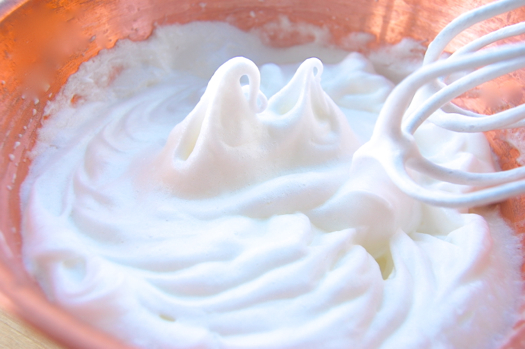Bubble, Bubble…Toil & Trouble

Reader K writes:
Joe, it seems like every time I see a recipe that calls for whipped egg whites I see the instruction “add cream of tartar or use a copper bowl”. Can you tell me why a copper bowl is the equivalent of adding cream of tartar? I just don’t understand it.
I would be delighted, K. As you may recall from past posts, the reason egg whites whip so nicely into foams is because of the proteins they contain. These proteins naturally occur in clumpy balls. But apply a little shearing force and the proteins uncoil, at which point they begin to bond to one another, forming networks. These networks collect on the surfaces of air bubbles, preventing them from popping.
The problem is that the same whipping action that uncoils egg proteins will cause them to clump back up again if you don’t quit while you’re ahead. The point of no return occurs somewhere right after the stiff peak stage, when the proteins that were arranged in nice regular lattices, bonded elegantly, cradling big bubbles of air…start to lose their mojo.
What happens? In a nutshell, the excess agitation causes the protein molecules to bond excessively to their neighbors and gather together in masses (coagulate). At that point they can no longer do their job on the watery bubble surface. The forces of surface tension start to take over again and the bubbles start to pop. The foam turns grainy, then clumpy, then watery, at which point it’s pretty much useless.
What to do about it? While nothing can ultimately protect an egg foam from too much whipping, there are a few steps you can take to broaden your margin of error. Specifically, you can add various substances to the mixture that preemptively plug up the proteins’ bonding sites. Copper ions serve that purpose very nicely, which is why more than a few egg white whippers like to use copper bowls.
On the less expensive side of the spectrum are some simple additives. Copper ions can be had in the form of a dietary supplement, available at your friendly neighborhood health food store. A somewhat less effective yet much more readily available option is acid in the form of vinegar, lemon juice or cream of tartar. Acids don’t affect the proteins’ bonding sites directly, though by changing the pH of the mixture they increase the number of free hydrogen molecules, and they gunk up the works quite nicely.
Thanks for the question, K!
I recently started watching episodes of the first couple seasons of “The French Chef” with Julia Child because they are free on Amazon Prime. She preferred whipping egg whites by hand in a copper bowl with a little salt but on the occasion she used an electric hand mixer, she would add a little cream of tartar. I wondered why the difference. Now I know. Thanks!
My pleasure, Kim!
– Joe